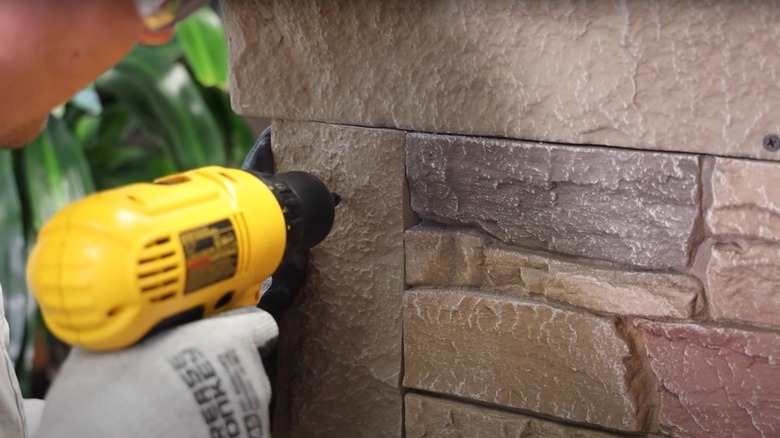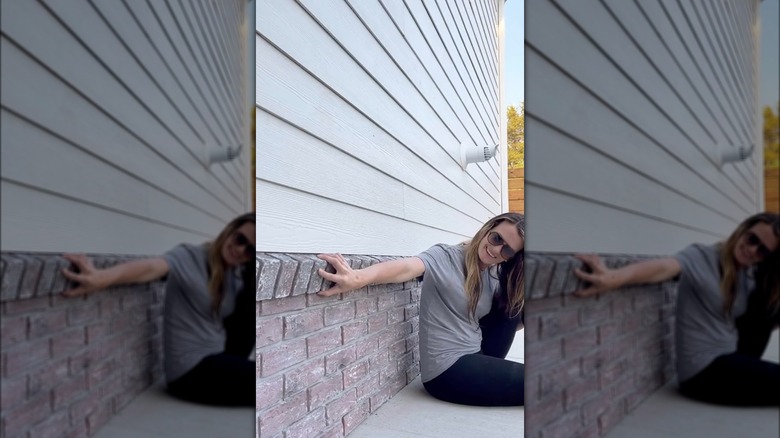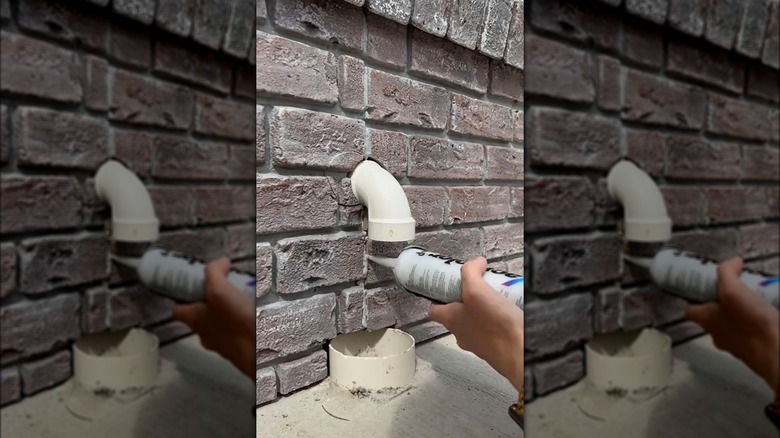Easily Change The Look Of Your Home's Exterior With TikTok's Faux Brick DIY
A solid foundation is essential to the construction of safe and well-built homes. A block foundation, made of hollow concrete blocks, can carry significant weight, far greater than poured concrete, making it a popular choice among home builders. However, no matter how well the gray or beige foundation does its job of supporting your home, it isn't the most beautiful material. A little bit of the foundation block remains visible near the ground on your home's exterior, which bothers some homeowners. No matter which of the different types of house siding you have, the installer will leave it at least six inches above the ground to prevent heavy rain from affecting the structure of the building, which means part of the foundation block is visible on most homes.
If you dislike this look, you can undertake a few different options for foundation refacing that can change the look of this area of your home and give it more curb appeal. TikTok users @brunoandlibby has an idea that delivers a quick fix by using brick veneer that covers the foundation and provides a completely different look for the space. The TikTok video made use of GenStone faux bricks, but you can find plenty of brick veneer products made for exterior use at your local hardware store or big box hardware stores. The GenStone product at HomeDepot costs $35 per panel with 1.88 square feet of coverage.
How to cover your foundation block with brick veneer
In the brunoandlibby TikTok video, the installers didn't give many detailed instructions on the tools required to do the work. They did use a cordless power drill, a cordless circular saw, and a caulking gun in the video. With the GenStone product, the manufacturer recommends also having safety glasses, latex gloves, a tape measure, a framing square, a utility knife, a level, construction adhesive, and deck screws.
Before adding veneer to the foundation block, you should wash it with a garden hose and a gentle sprayer to remove any dirt and grime. Allow it to completely dry. Allow your GenStone veneer panels to acclimate to the temperature in the area where the installation will occur for 48 hours. Make sure you have moderate temperatures and dry weather to do the installation.
To install the GenStone panels, you may need to cut some of them to fit vertically in the space. Draw your cutting line on the back of the panel and make your cut with the circular saw. You then can place construction adhesive on the back of the panel before adhering it to the foundation block. Once you have it in the exact location you want, you then can attach it with the deck screws on the tabs that appear on each panel. By placing screws on the tabs, you then can hide them with the next panel. Continue working along the foundation block until it's covered.
Considerations when attaching brick veneer panels to your foundation block
It's important to make the panel installation as watertight as possible. If water gets behind the veneer, you may want an air space between the foundation and the back of the veneer, allowing the moisture to drain away. In the TikTok video, the installers added a drainage tube consisting of PVC plastic pipe to aid with this problem. However, they did not explain how they did it. GenStone does not mention using PVC pipe in the installation to help with drainage. Instead, the company recommends using caulking to create a tight seal on all the seams to protect against water penetration.
Rather than painting the exterior brick veneer, you will need to use paint on the exposed caulk in the GenStone to ensure it blends with the veneer for the most desirable aesthetic result. GenStone offers paint kits to help you blend a matching veneer color.
Finally, when adding the brick veneer, it's important you do not affect the grade of the yard and expose the foundation to water damage. If you disturb the grade while you are working, build it back after you finish so water continues to run away from the foundation. In the TikTok video, the installers were working over a concrete sidewalk, so they did not have to worry about the grade of the ground underneath. You may have dirt, landscaping, or grass in the area where you are working, though.


